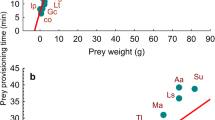Summary
The tenets of optimal foraging theory are used to contrast the behavior of the predatory snail Acantina spirata when feeding on the barnacles Balanus glandula and Chthamalus fissus under conditions of satiation and starvation. As predicted in optimal diet models, A. spirata is less selective (ratio of attack frequency on a prey species to number of individuals available) when the higher ranking prey has low abundance. When given a choice, starved snails attack both barnacle species equally, whereas satiated individuals preferentially attack B. glandula, the more profitable prey (ash-free dry weight of barnacles ingested per unit handling time). Under starvation conditions, equal attack frequency does not result in equal prey species consumption because Acanthina spirata is more successful at attacking C. fissus than B. glandula.
The assumption of constant prey encounter rates in optimal diet models is not met when A. spirata goes from a state of satiation to starvation. The encounter rate on B. glandula is lowered due to a decrease in attack success. A loss of feeding skills in starved A. spirata is responsible for the greater difficulty snails have in gaining access through the opercular plates of B. glandula.
Behavioral changes in A. spirata as snails pass from satiation to hunger translate into an energetic disadvantage during feeding for hungry snails for two reasons. First, higher prey handling times result in a decreased rate of biomass intake. Second, alteration in the relative attack frequency between barnacle species, combined with a decrease in attack success on the more profitable prey leads to more frequent ingestion of the less profitable prey.
Similar content being viewed by others
References
Akre BG, Johnson DM (1979) Switching and sigmoid functional response curves by damselfly naiads with alternate prey available. J An Ecol 48:703–720
Barnett BE (1979) A laboratory study of predation by the dogwhelk Nucella lapillus on the barnacles Elminius modestus and Balanus balanoides. J Mar Biol Ass UK 59:299–306
Bayne BL, Scullard C (1978) Rates of feeding by Thais (Nucella) lappillus (L.). J Exp Mar Biol Ecol 32:113–129
Bence J, Murdoch WW (1986) Prey size selection by the mosquitofish: relation to optimal diet theory. Ecology 67:324–336
Beukema JJ (1968) Predation by the three spined stickleback (Gasterosteus aculeatus L.): the influence of hunger and experience. Behaviour 31:18126
Charnov EL (1976) Optimal foraging: attack strategy of a mantid. Am Nat 110:141–151
Connell JH (1975) Some mechanisms producing structure in natural communities: a model and evidence from field experiments. In: Cody ML, Diamond JM (eds) Ecology and evolution of communities. Belknap Press, Cambridge, MA, pp 460–490
Dethier VG (1969) Feeding behavior of the blowfly. Adv Stud Behav 2:112–266
Emlen JM, Emlen MGR (1975) Optimal choice in diet: test of a hypothesis. Am Nat 109:427–435
Fox LR, Murdoch WW (1978) Effects of feeding history on shortterm and long-term functional responses in Notonecta hoffmanni. J An Ecol 47:945–960
Gelperin A (1972) Neural control systems underlying insect feeding behavior. Am Zool 12:489–496
Hamilton CL (1965) Control of food intake. In: Yamamota WS, Brobeck JR (eds) Physiological controls and regulations. Saunders, Philadelphia, PA, pp 274–294
Holling CS (1966) The functional response of invertebrate predators to prey density. Mem Entomol Soc Can 48:1–86
Hughes RN (1980) Optimal foraging theory in the marine context. Oceanogr Mar Biol Ann Rev 18:423–481
Hughes RN, Elner RW (1979) Tactics of a predator, Carcinus maenas, and morphological responses of the prey. J An Ecol 48:65–78
Krebs JR (1978) Optimal foraging: Decision rules for predators. In: Krebs JR, Davies NB (eds) Behavioural ecology. Sinauer, Sunderland, England, pp 23–63
MacArthur RH, Pianka ER (1966) On optimal use of a patchy environment. Am Nat 100:603–609
Menge BA (1972) Foraging strategy of a starfish in relation to actual prey availability and environmental predictability. Ecol Monogr 42:25–50
Murdoch WW, Oaten A (1975) Predation and population stability. Adv Ecol Res 9:1–131. Academic Press, New York, NY
Palmer AR (1980) A comparative and experimental study of feeding and growth in thaidid gastropods. Ph.D. Thesis, University of Washington, Seattle, USA 320p
Pastorok RA (1980) The effects of predator hunger and food abundance on prey selection by Chaoborus larvae. Limnol Oceanogr 25:910–921
Perry DM (1983) Optimal foraging in the predaceous rocky intertidal snail Acanthina spirata (Blainville, 1832). Ph D Thesis, University of Southern California, Los Angeles, CA, p 152
Perry DM (1985) Function of the shell spine in the predaceous rocky intertidal snail Acanthina spirata (Prosobranchia: Muricacea). Mar Biol 88:51–58
Pulliam HR (1974) On the theory of optimal diets. Am Nat 108:59–74
Pyke GH (1984) Optimal foraging theory: a critical review. Ann Rev Ecol Syst 15:523–575
Pyke GH, Pulliam HR, Charnov ER (1977) Optimal foraging: a selective review of theory and tests. Quart Rev Biol 52:137–154
Richards LJ (1982) Prey selection by an intertidal beetle: field test of an optimal diet model. Oecologia (Berlin) 55:325–332
Richards LJ (1983) Hunger and the optimal diet. Am Nat 122:326–334
Schoener TW (1969) Optimal size and specialization in constant and fluctuating environments: An energy-time approach. Brookhaven Symp Biol 22:103–144
Schoener TW (1971) Theory of feeding strategies. Ann Rev Ecol Syst 2:369–404
Schoener TW (1974) The compression hypothesis and temporal resources partitioning. Proc Nat Acad Sci 71:4169–4172
Ware DM (1971) Predation by rainbow trout (Salmo gairdneri): the effect of experience. J Fish Res Bd Can 28:1847–1852
Ware DM (1972) Predation by rainbow trout (Salmo gairdneri): the influence of hunger, prey density, and prey size. J Fish Res Bd Can 29:1193–1201
Wood L (1968) Physiological and ecological aspects of prey selection by the marine gastropod Urosalpinx cinerea (Prosobranchia: Muricidae). Malacologia 6:267–320
Author information
Authors and Affiliations
Rights and permissions
About this article
Cite this article
Perry, D.M. Optimal diet theory: behavior of a starved predatory snail. Oecologia 72, 360–365 (1987). https://doi.org/10.1007/BF00377564
Received:
Issue Date:
DOI: https://doi.org/10.1007/BF00377564




